Scaling ad campaigns on a tight budget feels like trying to fuel a rocket with a matchstick 🚀—possible, but only if you know the right tricks. If you’re a small business owner, startup marketer, or solopreneur juggling limited ad spend, this post is your playbook. We’ll break down five proven strategies to stretch your budget further, boost ROAS, and grow without burning cash. No vague theories—just practical steps you can implement today.
What Is Scaling, and Why Does It Matter for Small Budgets?
Scaling means increasing your ad account’s performance (clicks, conversions, revenue) without proportionally increasing costs. For low-budget advertisers, it’s not about spending more—it’s about **smarter allocation**. A 2023 study by WordStream found that 64% of small businesses waste ad spend on poorly optimized campaigns. By focusing on efficiency, you can compete with bigger players and turn tiny budgets into big results.
How to Scale Low-Budget Ad Accounts: 5 Tactics
1. Double Down on Top Performers 🏆
Identify your 20% of campaigns driving 80% of results (hello, Pareto Principle!). Use platforms like Meta Ads Manager or Google Analytics to sort campaigns by ROAS or CPA. Turn off underperformers and reallocate their budgets to winners.
Example: A Shopify store shifted $50/day from a stagnant campaign to their top-converting dynamic ad, increasing sales by 35% in two weeks.
2. Optimize Ad Scheduling ⏰
Not all hours are equal. Analyze when your audience converts most. For B2B? Focus budgets on weekdays 9 AM–5 PM. For e-commerce? Evenings and weekends often win. Use automated rules to pause ads during low-traffic times.
Pro Tip: Tools like AdsPolar simplify this by auto-adjusting bids based on real-time performance data—perfect for hands-off optimization.
3. Test “Micro-Budgets” with Precision 🧪
Allocate 10–15% of your budget to rapid A/B tests. Focus on one variable at a time: headlines, CTAs, or visuals. Use Facebook’s Dynamic Creative or Google’s Responsive Ads to automate testing.
Why It Works: Even a 5% increase in CTR can lower your CPC by up to 20%, according to HubSpot.
4. Leverage Lookalike Audiences 🔍
Create lookalikes of your top converters (e.g., purchasers, email subscribers). Start with a 1–2% similarity tier to balance reach and relevance. Layer on interest targeting for extra precision.
Case Study: A fitness app scaled their $20/day budget by targeting lookalikes of users who completed a 7-day trial, achieving a 4.2x ROAS.
5. Negotiate Ad Space Directly 🤝
Reach out to niche blogs, podcasts, or influencers for direct ad deals. You’ll often pay less than platform rates and gain highly engaged audiences.
Example: A skincare brand partnered with a micro-influencer ($500/month) and saw a 50% higher conversion rate vs. Instagram Ads.
Tips to Avoid Scaling Pitfalls
-
Monitor frequency caps: High ad frequency = audience fatigue. Keep it under 3–5 impressions/user/week.
-
Beware of “scale first” traps: Fix leaks (poor landing pages, unclear CTAs) before scaling.
-
Use automation wisely: Tools like AdsPolar can auto-pause underperforming ads and adjust bids—saving hours weekly.
Scaling on a budget isn’t about magic—it’s about focus, data, and agility. By reallocating budgets ruthlessly, testing smarter, and leveraging tools like AdsPolar for automated heavy lifting, you can turn constraints into advantages. Remember: Big results start with small, strategic steps.
